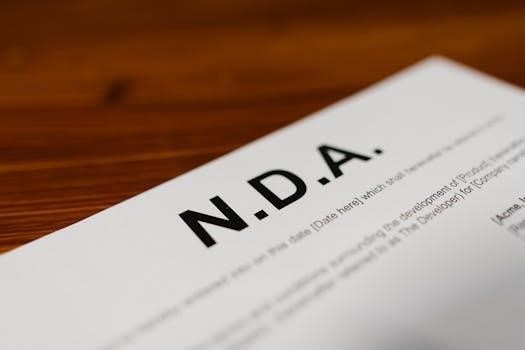Non-Refundable Deposit Agreement⁚ A Comprehensive Guide
A non-refundable deposit agreement is a legally binding contract outlining terms where a deposit is non-refundable. It’s used in various transactions, ensuring commitment from the buyer. This guide helps you understand the essentials of these agreements. It provides clarity for both parties involved, ensuring a smooth transaction.
What is a Non-Refundable Deposit Agreement?

A non-refundable deposit agreement is a legally binding contract between two parties, where one party pays a sum of money to another as a deposit for a product, service, or commitment. The key feature is that this deposit is non-refundable, meaning the payer forfeits the money if they back out of the deal, unless specific conditions are met and outlined in the agreement.
This type of agreement serves as a guarantee of intent. It provides security to the recipient, compensating them for potential losses incurred by holding the product or service and foregoing other opportunities. It is a common practice in industries such as real estate, event planning, and specialized product orders, where preparations begin upon receiving the deposit.
The agreement details the amount of the non-refundable deposit, circumstances under which it is forfeited, and any exceptions where a refund might be possible. It is crucial that both parties carefully review and understand the terms before signing, as it establishes their rights and obligations.
Key Elements of a Non-Refundable Deposit Agreement
A well-structured non-refundable deposit agreement should include several essential elements to ensure clarity and enforceability. First, the agreement must clearly identify all parties involved, including their full legal names and addresses.
Next, a precise description of the product or service for which the deposit is being made is crucial. This should include specific details that leave no room for ambiguity.
The agreement must explicitly state the amount of the non-refundable deposit and the method of payment. It should also clarify that the deposit is non-refundable, outlining the circumstances under which the deposit will be forfeited.
Furthermore, the agreement should specify the obligations of both parties, including timelines and deliverables. Any conditions under which the deposit might be refundable, such as failure to deliver the service, should be clearly defined.
Finally, it must include a clause stating that the payer agrees not to sue the company that was paid the deposit. Include governing law and jurisdiction, and signature lines for all parties, indicating their agreement to the terms.

Purpose of a Non-Refundable Deposit
The primary purpose of a non-refundable deposit is to provide the seller or service provider with a degree of financial security and compensation for potential losses. When a buyer commits to a purchase or service, the seller often incurs costs upfront, such as preparing goods, allocating resources, or turning away other potential customers.
The non-refundable deposit acts as a guarantee that the buyer is serious about the transaction and will fulfill their obligations. It compensates the seller for the time, effort, and expenses incurred in anticipation of the completed transaction.
Moreover, it can cover losses if the buyer cancels the agreement, preventing the seller from recovering costs. It also serves as a deterrent against frivolous cancellations, encouraging buyers to carefully consider their commitment before entering into the agreement.
In essence, the non-refundable deposit balances the risk between the buyer and seller, ensuring that the seller is not left bearing the full financial burden if the transaction falls through due to the buyer’s actions.
This arrangement fosters trust and mutual commitment in business dealings.
Situations Where Non-Refundable Deposits Are Common
Non-refundable deposits are frequently used in various industries to protect sellers from potential losses due to buyer cancellations. One common area is real estate, where buyers often put down a non-refundable deposit to secure a property while they arrange financing and conduct inspections. This protects the seller if the buyer backs out without a valid reason.
Event planning and catering services often require non-refundable deposits to cover initial expenses and ensure the event proceeds as planned. Custom orders, such as personalized goods or specialized manufacturing, also typically involve non-refundable deposits because the seller incurs costs that cannot be recouped if the buyer cancels.
The travel industry, including hotels, airlines, and tour operators, may use non-refundable deposits for bookings, especially during peak seasons, to minimize losses from cancellations. Rental agreements for properties or equipment also commonly include non-refundable deposits to cover administrative costs and hold the item for the renter.
In these situations, the deposit ensures commitment and compensates the seller for potential losses.
Legality and Enforceability of Non-Refundable Deposit Agreements
The legality and enforceability of non-refundable deposit agreements depend on various factors, including jurisdiction and specific terms. Generally, these agreements are enforceable if they are clear, concise, and mutually agreed upon by both parties. Courts often examine whether the terms are conscionable and not unduly harsh to one party.
For a non-refundable deposit agreement to be valid, it must comply with contract law principles. This includes offer, acceptance, and consideration. The agreement should clearly state that the deposit is non-refundable and under what circumstances it will be retained by the seller.
However, courts may scrutinize agreements where the deposit is disproportionately high compared to the total transaction amount. If the deposit is deemed a penalty rather than a reasonable estimate of potential damages, it may not be enforceable. Additionally, if the seller breaches the agreement, the buyer may be entitled to a refund, regardless of the non-refundable clause.
Consumer protection laws may also impact the enforceability of these agreements, particularly in transactions involving individual consumers rather than businesses. It is crucial to ensure the agreement complies with all applicable laws and regulations.
Drafting a Clear and Concise Non-Refundable Deposit Agreement
Drafting a clear and concise non-refundable deposit agreement is crucial for ensuring its enforceability and avoiding potential disputes. The agreement should begin by clearly identifying all parties involved, including their full legal names and addresses. It should also specify the date the agreement is being entered into.
The description of the goods or services being provided must be detailed and unambiguous. Include specific quantities, qualities, and any relevant specifications. The total price of the goods or services should be clearly stated, along with the amount of the non-refundable deposit.
The agreement must explicitly state that the deposit is non-refundable, except under specific circumstances, if any. These circumstances should be clearly defined. For example, the deposit may be refundable if the seller fails to deliver the goods or services as agreed.
Include a clause outlining the consequences of the buyer breaching the agreement, such as forfeiture of the deposit. Also, specify the method of payment for the deposit and any deadlines for payment. Ensure the agreement complies with all applicable laws and regulations. A well-drafted agreement minimizes misunderstandings and protects both parties.
Non-Refundable Deposit vs. Refundable Deposit
The primary difference between a non-refundable deposit and a refundable deposit lies in their treatment upon cancellation or breach of contract. A non-refundable deposit, as the name suggests, is retained by the seller if the buyer cancels the agreement, regardless of the reason for cancellation, unless otherwise specified in the agreement.
This type of deposit provides the seller with a degree of financial security, compensating them for potential losses incurred due to the buyer’s change of mind. Conversely, a refundable deposit is returned to the buyer if the transaction does not proceed, provided the buyer has not breached the terms of the agreement. Refundable deposits are more common in situations where there is less risk to the seller or where the buyer has more leverage.
The choice between these two types of deposits depends on the nature of the transaction, the level of risk involved, and the bargaining power of each party. Non-refundable deposits are often used for specialized goods or services, while refundable deposits are more typical for standard transactions with minimal risk.
Free Templates and Examples of Non-Refundable Deposit Agreements

Numerous resources offer free templates and examples of non-refundable deposit agreements to assist in drafting these important documents. These templates provide a basic framework that can be customized to suit specific transaction details. Online legal form providers often offer downloadable templates in PDF, Word, and other formats.
These templates typically include essential clauses such as the deposit amount, the purpose of the deposit, conditions under which the deposit is forfeited, and governing law. Examples of non-refundable deposit agreements can be found on websites specializing in legal documents and business contracts.
It is crucial to review these templates carefully and adapt them to the unique circumstances of your transaction. While templates offer a convenient starting point, seeking legal advice is recommended to ensure the agreement is legally sound and protects your interests. These resources are valuable for understanding the structure and content of these agreements, promoting informed decision-making.
How to Customize a Non-Refundable Deposit Agreement Template
Customizing a non-refundable deposit agreement template is essential to ensure it accurately reflects the specific terms of your transaction. Start by carefully reviewing the template and identifying sections that need modification. Ensure that the names of the parties involved, the deposit amount, and the description of the goods or services are accurate.
Clearly define the circumstances under which the deposit will be forfeited. This section should be detailed and unambiguous to avoid future disputes. Include any specific conditions or deadlines that must be met. Specify the governing law that will apply to the agreement, typically the law of the jurisdiction where the transaction takes place.
Add any additional clauses or provisions that are relevant to your particular situation. If the agreement involves unique terms or conditions, make sure they are clearly stated. Finally, have the customized agreement reviewed by a legal professional to ensure it is legally sound and enforceable. This ensures it protects your interests effectively.
Risks and Considerations for Both Parties
When entering into a non-refundable deposit agreement, both parties must carefully consider the associated risks. For the party providing the deposit, the primary risk is the potential loss of funds if they cannot fulfill the agreement. Circumstances may change, rendering them unable to proceed. It’s crucial to assess financial stability and commitment before agreeing to a non-refundable deposit. Review the agreement thoroughly to understand all conditions and potential forfeiture scenarios.
For the recipient of the deposit, risks include the possibility of disputes if the agreement is unclear or unfair. A poorly drafted agreement can lead to legal challenges and damage business relationships. The recipient must also be prepared to fulfill their obligations as outlined in the agreement, as failure to do so could result in legal repercussions.
Both parties should seek legal advice to ensure the agreement is fair, reasonable, and legally enforceable. Transparent communication and a clear understanding of terms are vital to mitigate potential risks. Consider alternative arrangements if the non-refundable nature poses significant hardship.
Legal Consequences of Breaching a Non-Refundable Deposit Agreement
Breaching a non-refundable deposit agreement carries significant legal consequences for both parties involved. If the party providing the deposit breaches the agreement by failing to complete the transaction, they forfeit the deposit. The recipient is entitled to retain the deposit as compensation for potential losses incurred due to the breach. Legal action may be pursued to recover additional damages if the deposit doesn’t fully cover the losses.
If the recipient breaches the agreement, they may be required to return the deposit and face legal action. The breaching party may be liable for damages, including direct losses, consequential damages, and legal fees. Court may order specific performance, compelling the recipient to fulfill their obligations.

The specific consequences depend on the agreement’s terms and applicable laws. Legal remedies may include monetary damages, specific performance, and rescission of the agreement. Seeking legal counsel is crucial to understand the potential legal ramifications and determine the best course of action.
A well-drafted agreement should clearly outline the consequences of breaching the terms.